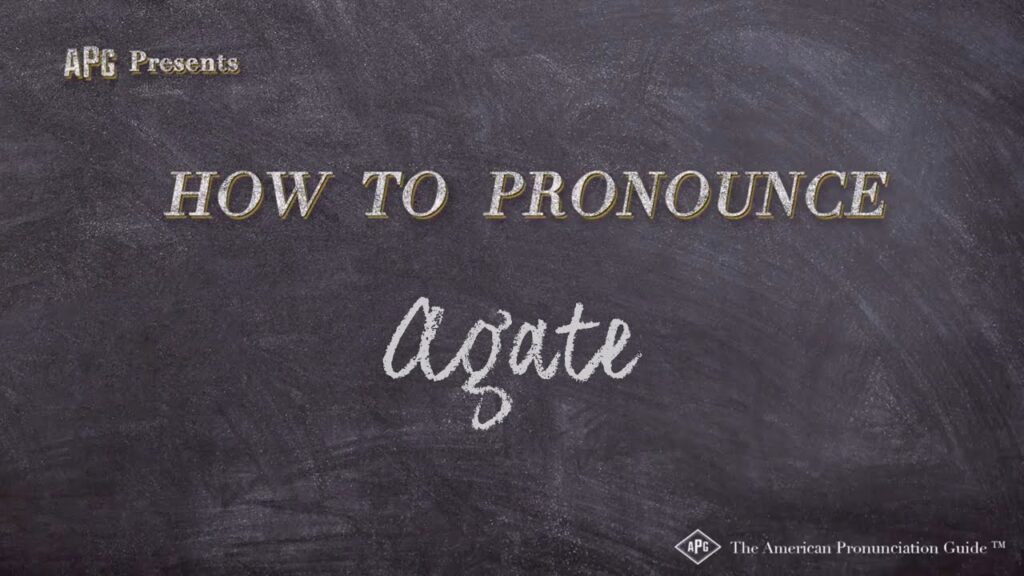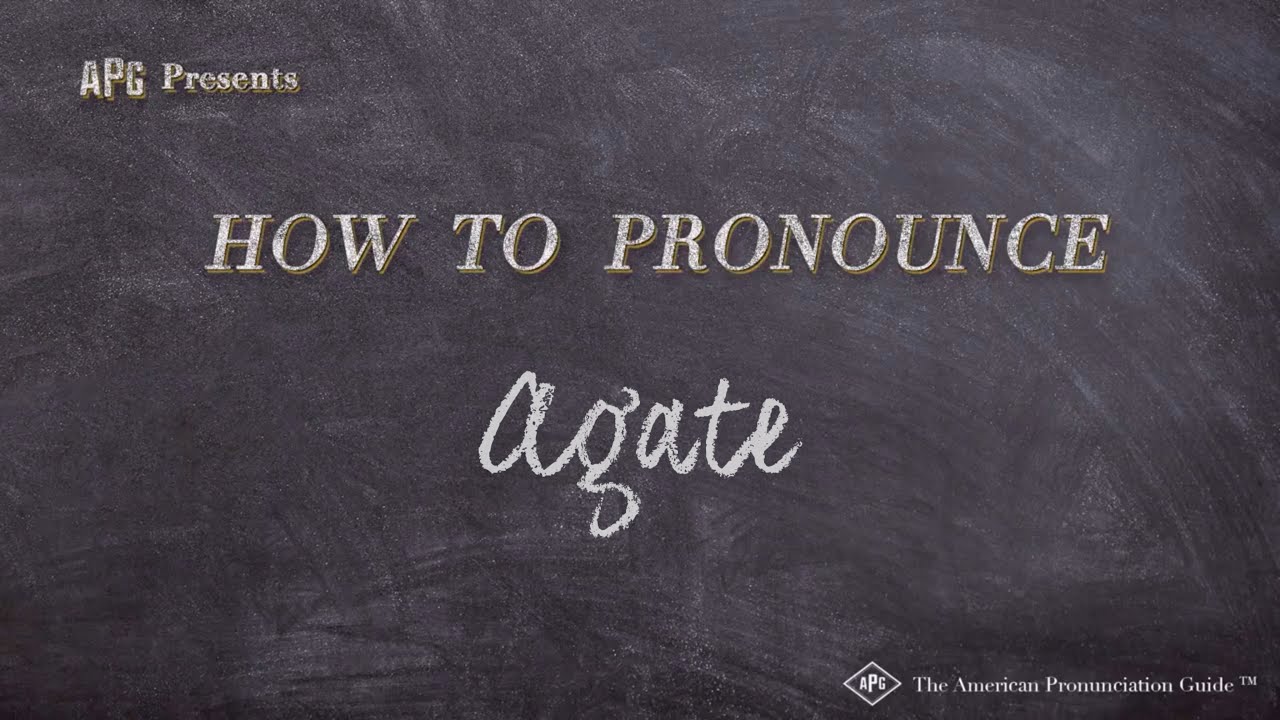
Mastering the Pronunciation of Agate: A Comprehensive Guide
Have you ever admired a beautiful agate stone and hesitated to pronounce its name correctly? You’re not alone. Many people find the pronunciation of agate, a gemstone prized for its beauty and unique patterns, surprisingly tricky. This comprehensive guide will break down the proper agate pronunciation, explore its etymology, and delve into fascinating facts about this captivating stone. We’ll ensure you can confidently discuss and admire agate without any linguistic stumbles. Understanding the nuances of agate pronunciation is the first step in appreciating its geological significance and cultural relevance.
Understanding the Basics of Agate Pronunciation
The most widely accepted pronunciation of agate in English is /ˈæɡət/. Let’s break this down:
- ˈæ: This represents the “a” sound as in “apple” or “cat.” It’s a short, open vowel sound.
- ɡ: This is the hard “g” sound, as in “goat” or “garden.”
- ət: This is the “ut” sound, as in “but” or “cut.”
Therefore, when you combine these sounds, you get /ˈæɡət/ – agate. Practice saying it a few times: agate, agate, agate. Pay attention to the short “a” sound and the hard “g.”
Common Mispronunciations to Avoid
One common mispronunciation is pronouncing the “a” as a long vowel, like in “ape” or “ate.” This would sound like “ay-gate,” which is incorrect. Another mistake is softening the “g” sound, making it sound like “aj-ut.” Stick to the hard “g” for the correct agate pronunciation.
The Etymology of Agate: A Journey Through Language and History
To further understand the word agate, let’s explore its etymology. The name “agate” comes from the Achates River (now known as the Dirillo River) in Sicily, Italy. This river was a significant source of agate stones in ancient times. The ancient Greeks called the stone “achates lithos,” meaning “stone of Achates.” Over time, this evolved into the Latin word “achates,” which eventually became “agate” in English and other European languages.
Knowing the origin of the word can help you remember its pronunciation. Think of the “a” in “Achates” as a clue to the short “a” sound in agate.
Types of Agate and Their Unique Characteristics
Agate is a variety of chalcedony, which is a microcrystalline form of quartz. It is characterized by its fine grain and bright colors. Agates form in volcanic and metamorphic rocks, often as nodules or veins. The distinct banding and patterns within agate stones are due to the deposition of silica-rich fluids over time. [See also: Understanding Chalcedony Formation]
There are numerous types of agate, each with its own unique appearance and properties. Some popular varieties include:
- Banded Agate: Features concentric bands of different colors.
- Moss Agate: Contains inclusions that resemble moss or foliage.
- Fire Agate: Exhibits iridescent colors due to layers of iron oxide.
- Botswana Agate: Known for its delicate pink and gray bands.
- Dendritic Agate: Displays tree-like patterns formed by manganese or iron oxides.
While the pronunciation of agate remains the same regardless of the variety, understanding the different types can enrich your appreciation for this diverse gemstone. The beauty of agate lies not only in its appearance but also in its geological history.
Agate in Jewelry and Decorative Arts
Agate has been used in jewelry and decorative arts for centuries. Its durability, beauty, and variety of colors make it a popular choice for pendants, beads, cabochons, and carvings. Agate is also used in creating ornamental objects, such as vases, bowls, and paperweights. The unique patterns and colors of agate make each piece truly one-of-a-kind.
When discussing agate jewelry, be sure to use the correct pronunciation to showcase your knowledge and appreciation for the gemstone. Whether you’re admiring a delicate agate pendant or a bold agate ring, knowing how to pronounce its name correctly adds to the experience.
Agate’s Metaphysical Properties and Cultural Significance
Beyond its aesthetic appeal, agate is also believed to possess metaphysical properties. In various cultures, agate is associated with protection, strength, and harmony. It is thought to promote emotional balance, enhance concentration, and boost self-confidence. Some people use agate in meditation practices to promote inner peace and clarity. [See also: The Healing Properties of Gemstones]
Throughout history, agate has held cultural significance in different societies. Ancient civilizations used agate for amulets, seals, and decorative objects. The Romans believed that agate could protect them from storms and ensure good harvests. In some cultures, agate is associated with fertility and abundance.
Whether you believe in its metaphysical properties or simply appreciate its beauty, agate remains a fascinating and versatile gemstone. And now, you can confidently discuss its attributes, knowing the correct agate pronunciation.
Tips for Remembering the Correct Agate Pronunciation
Here are a few tips to help you remember the correct pronunciation of agate:
- Associate it with “apple-gate”: Think of the phrase “apple-gate” to remember the short “a” sound and the hard “g.”
- Break it down: Remember the phonetic transcription: /ˈæɡət/.
- Practice regularly: Say the word agate aloud several times each day.
- Listen to recordings: Search online for audio clips of the word agate being pronounced.
- Use it in conversation: Incorporate the word agate into your conversations to reinforce the pronunciation.
By following these tips, you can master the pronunciation of agate and confidently use the word in your vocabulary.
Conclusion: Embrace the Beauty and Pronunciation of Agate
Agate is a gemstone that captivates with its beauty, variety, and geological history. By understanding the correct agate pronunciation, you can fully appreciate this remarkable stone and communicate your knowledge effectively. Remember to pronounce the “a” as in “apple” and the “g” as in “goat.” With practice and attention, you’ll be able to confidently discuss agate with friends, colleagues, and fellow gemstone enthusiasts.
So, the next time you encounter a stunning piece of agate, don’t hesitate to admire its beauty and pronounce its name with confidence. You now have the knowledge and tools to master the pronunciation of agate and delve deeper into the fascinating world of gemstones.

